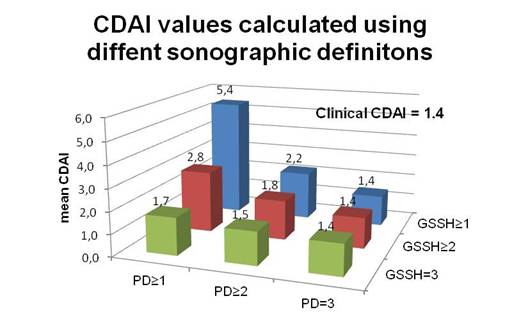Session Information
Session Type: Abstract Submissions (ACR)
Background/Purpose:
Sonographic assessment of joint activity in patients with rheumatoid arthritis (RA) is considered to be more sensitive than the respective clinical assessment. However, this difference may be less dependent on the physical technique used (i.e. palpation vs. ultrasound), but rather related to differences in arbitrary definitions of the presence or absence of “joint activity“. We aimed to evaluate the differences in numbers of clinically and sonographically active joints in RA, with special regard to the impact of sonographic definitions of activity.
Methods:
We performed sonographic imaging of 22 joints of the hands of RA patients in clinical remission (n=60; defined as Clinical Disease Activity Index=CDAI ≤ 2.8). Each joint was assessed for grey scale synovial hypertrophy (GSSH) and power Doppler (PD) signal on a four point scale (0=no, 1=mild, 2=moderate and 3=marked). We investigated the sensitivity and specificity of clinically swollen joints for presence of sonographic activity, when using different cut points and combinations of sonographic definitions of activity. For the clinical assessment we used the strict conventional approach of not calling a joint swollen in case of any doubt. We then assessed changes of CDAI if the clinical swollen joint count (SJC) was replaced by sonographically active joints.
Results:
Among the 1320 joints of patients in remission a total of 887 (67.2%) were GSSH positive and 269 (20.4%) were PD positive.
Clinical joint swelling was 100% specific for sonographic activity, even when stringent sonographic criteria (score=3) were applied. The maximum sensitivity was 25% using the most stringent sonographic criteria (GSSH=3 and PD=3).
Calculating CDAI by replacing the number of clinically swollen by the number of sonographically active joints (sCDAI) according to the various definitions above, resulted in high values using GSSH≥1 or PD≥1 (mean sCDAI=15.5) compared to the clinical CDAI of 1.4. However, sCDAI values approached the clinical CDAI with increasing stringency of the sonographic definition used, and were even numerically identical when accepting only grade 3 PD signals (Figure).
Conclusion:
Sonography revealed residual signals of joint activity in patients in CDAI remission. Changing the stringency of the sonographic criteria toward higher signals for determination of joint activity led to similar results when considered in the context of overall disease activity, such as in the CDAI.
Disclosure:
M. Gärtner,
None;
H. Radner,
None;
G. Supp,
None;
P. Mandl,
None;
D. Aletaha,
None;
K. P. Machold,
None;
J. S. Smolen,
None.
« Back to 2012 ACR/ARHP Annual Meeting
ACR Meeting Abstracts - https://acrabstracts.org/abstract/does-joint-sonography-really-add-clinically-important-information-beyond-clinical-joint-examination/

